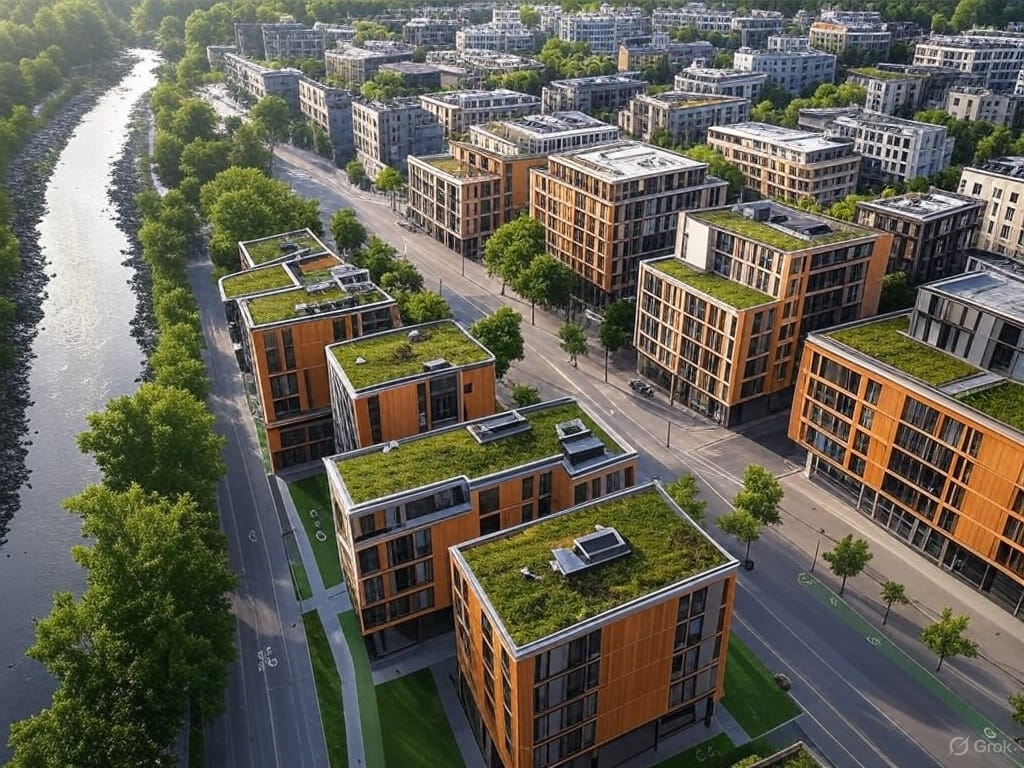Building Resilient Communities
From flood-proof floating homes in Amsterdam to Toronto’s cooling green roofs, resilient urban design blends innovation and nature to build cities that thrive amid climate challenges.

As the planet grapples with rising sea levels, extreme weather, and resource scarcity, urban planning and architecture are evolving to build resilient communities. No longer a futuristic dream, resilience blends innovative design with nature’s rhythms to create homes and cities that endure and thrive. This article explores how thoughtful urban planning and architecture adapt to a changing world, with real-world examples and practical ways to build resilience locally.
Understanding Resilience in Urban Design
Resilience in urban design means crafting spaces that withstand and adapt to environmental, social, and economic stressors—floods, heatwaves, population growth, even earthquakes. Unlike traditional planning, which often favored short-term efficiency, resilient design prioritizes long-term adaptability. It embraces nature, restoring wetlands to absorb floodwater instead of erecting concrete barriers or designing buildings to stay cool without heavy reliance on air conditioning. These strategies mitigate risks, boost livability, and sustain communities.
Flood-Proof Homes: Engineering for Water
Flooding, worsened by climate change and urbanization, threatens cities worldwide. Traditional homes often fail under water’s force, but flood-proof architecture works with it.
Elevated Structures
In the Netherlands, where low-lying land meets rising seas, architects elevate homes to outsmart floods. Amsterdam’s IJburg neighborhood features floating houses on pontoons, rising with storm surges—a model now used in Bangladesh and the U.S. Gulf Coast, where a 2024 study showed a 30% reduction in flood damage for elevated designs.
Permeable Materials and Design
Flood-proof homes also use smart materials and layouts. Thailand’s Baan Amphibious House has open ground floors, letting water pass through to protect upper levels. Permeable pavements, adopted in Copenhagen, allow rainfall to seep into the ground, reducing runoff. These innovations cut property damage and the emotional and financial toll of rebuilding.
Green Roofs: Cooling Cities Naturally
Urban heat islands, where concrete traps heat, make cities swelter. Green roofs—rooftops with plants—cool buildings, capture rainwater, and enrich ecosystems.
Toronto’s Green Roof Revolution
Since a 2009 bylaw, Toronto has led with green roofs on new commercial buildings. These host meadows, gardens, and beehives, cutting energy use by up to 15% and easing stormwater systems, per a 2023 city report. They also support pollinators, vital to food security.
Beyond Cooling: Social and Economic Gains
In Singapore, skyscraper green roofs double as social hubs, strengthening community ties. In Chicago, they boost property values and tourism, driving investment. These designs prove resilience can be functional and beautiful.
Restoring Nature in Urban Planning
Resilient cities rethink their bond with nature, reversing sprawl that destroys wetlands and forests—natural buffers against disasters.
New York’s Living Shorelines
After Hurricane Sandy hit New York City in 2012, the Staten Island Living Breakwaters project combined artificial reefs and native plants to curb erosion and protect coasts. Unlike rigid seawalls, these living systems strengthen over time, adapting to rising seas and nurturing marine life.
Sponge Cities in China
China’s 2015 “sponge city” initiative transforms places like Wuhan with wetlands, rain gardens, and porous roads to absorb rain. A 2025 update shows these cut flood risk by 25% while recharging groundwater, inspiring cities like Berlin and Melbourne.
Energy and Resource Resilience
Resilience also means reliable energy and resources during crises, from storms to supply disruptions.
Passive Design for Energy Efficiency
Passive design uses a building’s shape, orientation, and materials to regulate temperature. In Freiburg, Germany, Vauban’s solar-powered “energy-plus” homes produce surplus power, staying comfortable during outages—a boon in extreme weather.
Circular Systems for Resources
In Kalundborg, Denmark, factories share waste—excess heat powers operations, fly ash becomes cement. Amsterdam mirrors this, turning food waste into biogas and recycling construction materials, ensuring resources endure disruptions.
Real-World Success Stories
These strategies shine worldwide:
- Rotterdam’s Multifunctional Resilience
Rotterdam, below sea level, blends utility and beauty. The Benthemplein water square serves as a plaza and rainwater reservoir, while rooftop farms and floating pavilions cement its status as a resilience pioneer. - Medellín’s Social Resilience
Medellín, Colombia, healed from violence with cable cars and escalators linking hillside neighborhoods to jobs, plus green corridors that cool and connect communities. This shows resilience can mend social bonds, too.
Getting Involved Locally
You can build resilience at home. Here’s how:
- Advocate for Smart Planning
Attend city council meetings or join planning groups to push for green infrastructure—bike lanes, rain gardens. Share examples like Toronto’s green roofs. Check city websites for idea-submission portals. - Retrofit Your Space
Install rain barrels or plant native species to cut water use. Renters can push for energy-efficient upgrades or start rooftop gardens. Insulate walls or add reflective blinds for impact. - Build Community Networks
Join neighborhood groups to share tools, seeds, or disaster prep tips. Use Nextdoor or local climate action networks to connect and strengthen resilience. - Support Local Ecosystems
Volunteer with groups like Riverkeeper (U.S.) or Thames21 (UK) for cleanups or planting days, bolstering natural defenses and your tie to the land.
The Road Ahead
Resilient communities demand vision, collaboration, and persistence. By designing with nature—flood-proof homes in the Netherlands, green roofs in Singapore—we build places that thrive amid change. Planners, homeowners, and neighbors all have roles, from sketching sponge cities to planting rain gardens. Explore local initiatives, start small, and act today—your city’s future depends on it.





